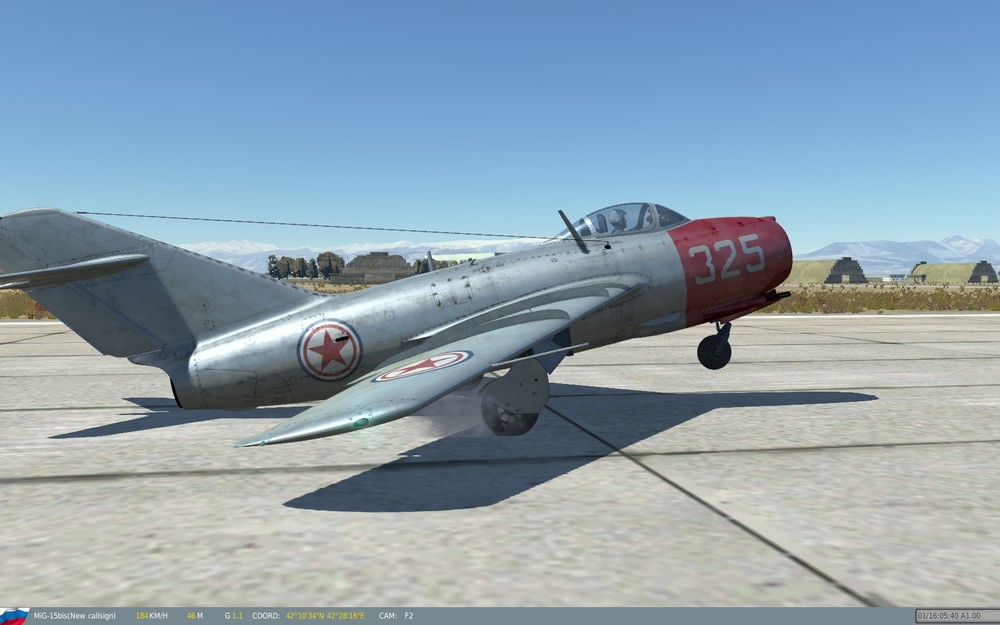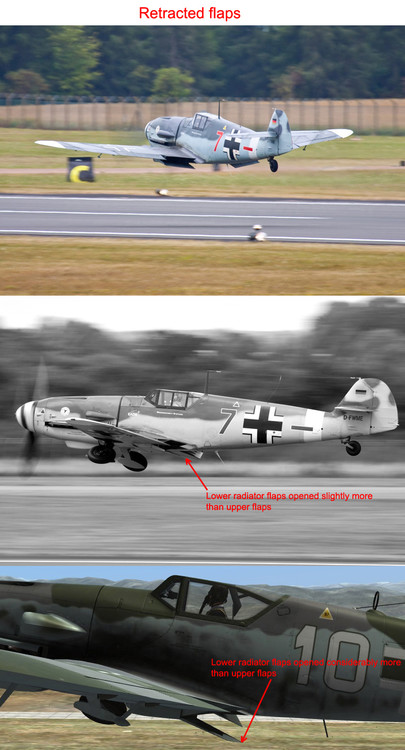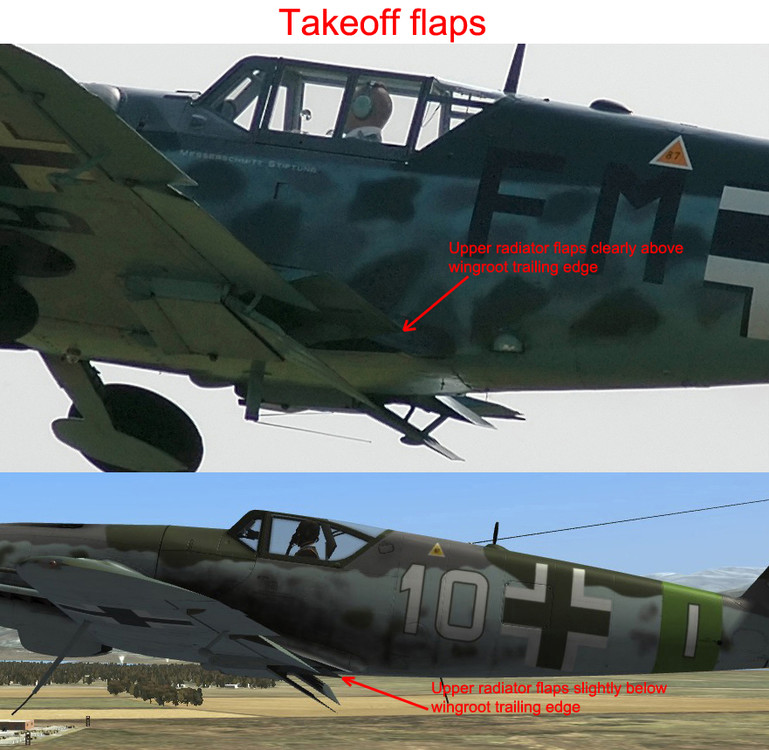-
Posts
447 -
Joined
-
Last visited
-
Days Won
2
Content Type
Profiles
Forums
Events
Everything posted by Fox One
-
Here is a picture with the dispenser visible. 30 chaff and 15 flare. https://farm9.staticflickr.com/8046/8085382997_6b933e79db_o.jpg
-
From AV-8B manual 1998, LAU-117 only.
-
A question for any owner of MiG-21 module When the cockpit AoA indicator shows 30deg, what is the true AoA shown in F2 view? Thanks
-
I also use the X-55 stick and for all fast jets I use some curve, at least for pitch. The Mirage is the only plane where I use negative curves for both pitch and roll, and I'm still quite annoyed by its unresponsiveness as described in posts above. Especially in pitch, it feels like you're flying a much much larger aircraft. The "nimbleness" is simply not there.
-
^^^ That small picture from a completely inadequate angle is your "proof" ? And drop your "block numbers" theory. The instruments and panels you see in cockpits in various pictures posted in this thread are completely irrelevant. This is about windshield shape. There are technical manuals and parts catalogue manuals for F-1 to F-40 versions, there is only one type of windshield. The windshield in simulator does not look like the one on the real F-86F (of any subvariant), period end of story. But I invite you to find a picture of F-86 of any variant, not only F from inside the cockpit or from outside that does look like the one in simulator. I'm waiting anxiously
-

AIM-120 seeker lock and AIM-7 Flood mode question
Fox One replied to Beamscanner's topic in F-15C for DCS World
Exactly. I also think there is no fighter to missile datalink. Such antenna is nowhere to be found on AIM-54. I think for a AIM-54 very long range shot it works like this: there is an inertial guidance phase, a SARH phase and an active radar phase. The inertial phase is obviously necessary because, as long as the target is not huge, for a long range shot the missile will most likely not be able to SARH it right from the start. So there will be inertial guidance with the missile's antenna looking where it was instructed to look before launch until the missile radar antenna can sense the F-14's radar pulses reflected by target. If during the inertial phase the target makes a significant heading change and it is not within a cone of a certain size where the missile expects to start SARH, the missile is lost. They would probably never make a very long range shot on a suspected small, maneuverable aircraft - too much risk to lose the missile. They would wait for a range where SARH is available right from the beginning. There is data for R-27R SARH seeker. For a 10 sqm target, the seeker will see the target at 40Km. You can easily assume significantly better AIM-54 seeker performance in SARH mode - its antenna has a considerably larger diameter than R-27 and it is a slotted planar array design, much better antenna characteristics than R-27R's archaic type. -
Great job sedenion with this and with VTB - with your attention to detail you should be a DCS developer :)
-
@sedenion great gif! GGTharos brags at about every 10 posts he writes about some AIM-7 info only he has ... :D
-
In this video @4m18s a glimpse at 530 missile launch envelope at low altitude. In the screenshot below I modified a bit brightness&contrast. Target designator square visible in upper HUD, steering dot centered, closure is 800something kts and a useful piece of info - missile estimated flight time of 24s :)
-
JuanOscar, please make the version you have most data for, even if it's not necessarily the most interesting.
-
@Orr89 :D No, I was asking what manuals they have for the real aircraft to be able to make an accurate&complete simulation. I'm still waiting for RAZBAM to answer the question... What you see in RAZBAM's FS sim manual is like 5% of the functionality of the real jet. Or less...
-
Accurate measurements on the video: the distance is decreasing 0.6NM in precisely 2.72s. This gives an average closure of 794KTAS.
-
It's not. The frequency of the blinking "MAG" is the same as in other videos.
-
http://forums.eagle.ru/showpost.php?p=2630685&postcount=31
-
My vote depends on RAZBAM's answer to the question: what manuals do you have for GR7/GR9?
-
Gators, please ask the Mirage pilot how the target looks like on the radar display in search mode. Personally I have some doubts it really looks like a V as implemented in the simulator.
-
I suspected the simulator was not right about this. When performing aerobatics or dogfight, every time speed drops below 230 the alert sounds, pretty annoying. This does not happen in the youtube HUD video peforming aerobatics when the speed is below 230. Thanks for the info!
-
Here is a track for beginners having trouble taking off: Mustang takeoff in 2.0 without touching the rudder pedals. The right rudder deflection you see after I advance the throttle is not me pressing the right pedal, it is the propeller wash pushing against the deflected rudder trim tab and the tab itself is deflecting the rudder right. My feet never touched the rudder pedals the whole time. My point is, actually taking off with P-51 is easy, there is only a little correction required. The typical beginner mistake is overcontrolling the rudder, when in fact leaving it alone and the aircraft would almost go straight! Mustang TO.trk
-
I don't think the takeoff and landing characteristics are correct. In MiG-15bis "Flight characteristics" book (Book 1) they say the landing speed is 170 Km/h for a weight of 3915 Kg. In "Piloting technique" book for MiG-15bis and MiG-17 they say landing speed is 172-176. I have tried to make the slowest landing possible in simulator. Performed the landing with gun ammo removed and like 100 liters of fuel remaining. My touchdown speed was 184 (see screenshot below) with the bumper under the tail only about an inch above the runway. The aircraft was practically stalled, with little control remaining and with the tendency to bank. And despite the extreme landing and minimum weight I was only able to land at 184 Km/h. It is safe to say that landing at 170 Km/h is impossible. And I would add that in the simulator even at minimum weight for a comfortable and safe AoA the touchdown speed should be 200-210 MINIMUM. Takeoff speed is given in Book 1 as 220-230 for a weight of 4960. Same speed is given in the other book. Performing takeoff at this weight the aircraft got airborne at a speed of 240, however the nose was raised a lot with pretty little tail clearance ramaining, and the artificial horizon in cockpit was showing about 12 deg. First thing - in reality the takeoff and landing with this aircraft was NOT performed at Rafale-like AoA. Quite far from it. In "Piloting technique" book they actually describe what the position with the nose raised should look like - nosewheel about 20-25 cm above runway. I made some measurements on very accurate MiG-15bis scale drawings and the 25 cm they talk about would mean a pitch angle of about 7.25 deg. That would be a typical pitch angle for takeoff and landing, not 12 deg. Visually, this 25 cm means the nose wheel is raised above runway only about half of its diameter! In simulator, at takeoff (with 20 deg flaps) at a weight of 4960 if you raise the nose to just 7-8 deg the aircraft gets airborne at 300 Km/h. All I described above strongly suggest that in takeoff and landing configuration, for a given AoA the aircraft is producing considerably less lift than it should. I don't know if it's the lift of the entire aircraft that is low or is just the effectiveness of the flaps that is too low.
-

Su-27 trim issue is in need of explanation
Fox One replied to Hummingbird's topic in Su-27 for DCS World
^^^ No, I use X55 stick. -

Su-27 trim issue is in need of explanation
Fox One replied to Hummingbird's topic in Su-27 for DCS World
Yo-Yo, please do the following experiment: After takeoff with 56% fuel, accelerate at low level to 1000Km/h, trimming for horizontal flight. Reduce speed to 400Km/h, leaving the trim where it was. Engage full AB and pull the stick fully back and perform consecutive slow loops, maintaining the stick full aft. The AoA will oscillate around 19-21 deg, the only way to reach 24 deg AoA again is by applying trim aft. Is that behaviour correct or it is an error? -
http://forums.eagle.ru/showthread.php?t=135574
-
Here is the old thread with more pictures: http://forums.eagle.ru/showthread.php?t=127712 For me, visual accuracy is very, very important, but I don't think this will ever be corrected. Reason - 99.9% of the owners don't care about it.
-
I think the radiator flaps animation needs adjustments. See the images below. In all DCS screenshots I used the flaps was set to fully open.
-

stick forces-please make them optional
Fox One replied to 9.JG27 DavidRed's topic in DCS: Bf 109 K-4 Kurfürst
I think David has a point. Consider the following example. Flying at low level, 500 Km/h, full throttle, I pull the stick very slightly and enter a loop, then freeze the stick position in pitch. As the speed decreases, the controls indicator shows the stick as being pulled more and more, until the plane stalls. But I haven’t done that! I haven’t pulled the stick more and more to cause the stall! My hand maintained the same stick position in pitch of about only 15% pull, insufficient to stall the plane in this condition. I can reasonably well appreciate how much I pull on my joystick. How am I supposed to appreciate how much the plane’s stick is actually being pulled? If I pull the stick a certain amount, I’m expecting the stick to remain in that position as long as the necessary stick force is less than the maximum the simulation accepts the pilot is able to exert. If the speed is increasing and the necessary force is greater than the current one, so be it, reduce the elevator deflection according to that. I did an experiment with the 109 in 1.2.14 and performed like 10 consecutive loops with constant stick position in pitch. In 1.2.15 this exercise requires constant attention. When should I start to ease the pull on the stick? And by how much? The end result is during maneuvers with decreasing speed at a constant joystick position in pitch the aircraft is quickly increasing the AoA. So I return to the original loop example. At 500 Km/h I pull the stick about 15% of its full travel. If the stick in planes’s cockpit remains in this 15% pull position, the aircraft will perform the loop without stalling. But in order to keep the plane’s stick in the 15% position while speed is decreasing, I have to reduce the amount I pull on my joystick. The result is that, in the ascending part of the loop I need to continuously reduce the pull while the speed is decreasing, compared to real life where if I keep reducing the pull in the ascending part of the loop the AoA will get smaller and smaller while the speed is smaller and smaller and the plane won’t even reach the top. See the massive difference? The result is the required technique you use to physically pull on the joystick differs fundamentally from what you do with the stick in reality.







